
Keywords
gel
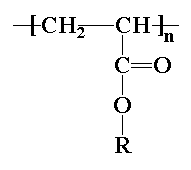 Acrylates are a family of polymers, which are a type of vinyl polymer. Acrylates are of course made from acrylate monomers, and it's about time we explained what those are. Acrylate monomers are esters which contain vinyl groups, that is, two carbon atoms double-bonded to each other, directly attached to the carbonyl carbon.
Acrylates are a family of polymers, which are a type of vinyl polymer. Acrylates are of course made from acrylate monomers, and it's about time we explained what those are. Acrylate monomers are esters which contain vinyl groups, that is, two carbon atoms double-bonded to each other, directly attached to the carbonyl carbon.
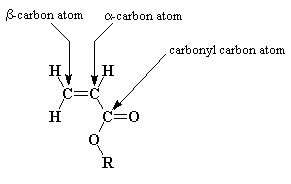
Some acrylates have an extra methyl group attached to the alpha carbon, and these are called methacrylates. One of the most common methacrylate polymers is poly(methyl methacrylate).
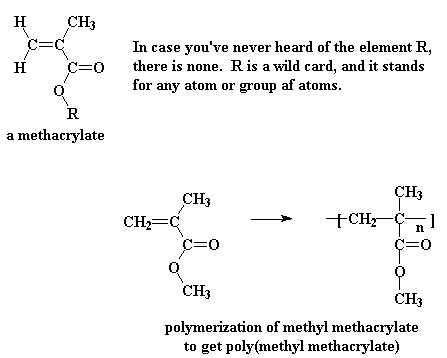
Acrylate and Methacrylate
one of Nietzsche's lesser known works
One might not think that this little methyl group would make a whole lot of difference in the behavior and properties of the polymer, but it does. Poly(methyl acrylate) is a white rubber at room temperature, but poly(methyl methacrylate) is a strong, hard, and clear plastic.
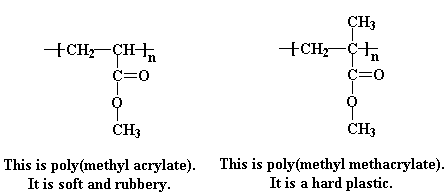
As it turns out, how soft or hard a polymer is at a given temperature is determined by what we call chain mobility, that is, how well the polymer chains wiggle past and around each other. The more they can move, the softer the polymer is. It helps here to think the scene in the movie Raiders of the Lost Ark, in which our hero Indiana Jones finds himself in an Egyptian temple and ankle deep in slithery poisonous snakes. Polymer chains are like those snakes. Smooth snakes can move past each other very easily. But if you could imagine those snakes having giant barbed spikes all up and down their backs like some of the dinosaurs in another Steven Spielberg film, you can see that they might not be moving around quite as much on the floor of that Egyptian temple.
Their spikes would catch on each other, and slithering would become quite difficult.
Poly(methyl methacrylate) is like one of those snakes with giant barbed spikes all up and down its back, with those extra methyl groups acting like the spikes to put a quick stop to any slithering the poly(methyl methacrylate) chains would try to do. Poly(methyl acrylate), on the other hand, is like the smooth snakes. Without that extra methyl group getting in the way, they can slither all they want. If the polymer chains can slither and wiggle past and around each other easily, the whole mass of them will be able to flow more easily. So, a polymer which can move around easily will be soft, and one which can't will be hard,
to put it simply.
If you want to know more about how polymers are like snakes take a look at the glass transition temperature page.
No More Saggy Diapers That Leak
The simplest acrylate polymer is one of the least well understood. And that would be...
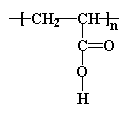
Poly(acrylic acid)!
This is what we call a polyelectrolyte. That is to say, each repeat unit has an ionizable group. In this case, it's a carboxylic acid group. Poly(acrylic acid) is bizarre because it soaks up water like crazy. It absorbs many times its own weight in water with no problem. Polymers that do this are called superabsorbers. So some bright individual had the bright idea of putting this stuff into baby diapers. In a diaper poly(acrylic acid) absorbs the little mess your little bundle of joy leaves behind. Remember all those diaper commercials where they pour that blue stuff on the diapers and it disappears? What you saw was poly(acrylic acid) in the act of superabsorption.
And don't think for one minute that we have the slightest idea why
poly(acrylic acid) can absorb so much water. We're completely clueless!
The advantage of having diapers with poly(acrylic acid) in them, aside from the fact that they're less messy, is that once the mess is locked up in the poly(acrylic acid), baby doesn't have to sit in it until mom and dad figure out that it's time for a change. Otherwise, baby could get some unpleasant skin rashes.
A Little Nitrogen Music
There are several derivatives of polyacrylates which contain nitrogen. Polyacrylamide and polyacrylonitrile are two shown in the picture. Polyacrylonitrile is used to make acrylic fibers. Polyacrylamide will dissolve in water and is used industrially. Crosslinked polyacrylamides can absorb water. (Crosslinked polymers can't really dissolve, if you think about it.) These gels are used to make soft contact lenses. It's the absorbed water in them that makes them soft. To see the polymer and its
monomer acrylamide in 3-D, click here.
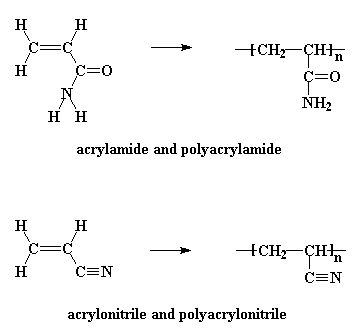
Now read a story I wrote about acrylates. It's called...
What Wonders Acrylates Can Do.
 Acrylates are a family of polymers, which are a type of vinyl polymer. Acrylates are of course made from acrylate monomers, and it's about time we explained what those are. Acrylate monomers are esters which contain vinyl groups, that is, two carbon atoms double-bonded to each other, directly attached to the carbonyl carbon.
Acrylates are a family of polymers, which are a type of vinyl polymer. Acrylates are of course made from acrylate monomers, and it's about time we explained what those are. Acrylate monomers are esters which contain vinyl groups, that is, two carbon atoms double-bonded to each other, directly attached to the carbonyl carbon.







